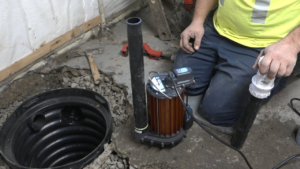As a homeowner, it’s important to know how to fix common plumbing problems. This can save you money on repair bills and give you a sense of accomplishment.

Leaky pipes can lead to water damage, mold growth and higher utility bills. Learn how to identify the leak, shut off the water supply and patch up the pipe like a professional. Contact Plumbing Repair Dallas County for professional help.
When your pipes or drains are cracked, leaking, or clogged, a plumber can inspect the situation and provide a timely repair. Professional plumbing services can also offer preventative maintenance to keep your home’s pipes and fixtures in tip-top shape.
Professional plumbers have a wide range of tools and skills at their disposal to quickly and efficiently repair your home’s plumbing issues. They can also offer advice on how to avoid future problems and help you save money on energy costs by providing tips on water conservation.
Plumbing repairs can include everything from fixing a dripping faucet to replacing a damaged toilet tank or water heater. In addition, a plumber can install or replace a new water shut off valve for your home’s main water supply line to fix leaks and reduce water waste.
Pipes are essential to providing clean and safe drinking water for your family, but they can corrode or become blocked with debris over time. A plumber can evaluate your home’s water quality and recommend the right solutions, from repiping to installing a water filtration system.
Even seemingly minor plumbing issues, such as a dripping faucet, can lead to significant damage and higher utility bills if left unattended. A plumber can repair or replace the fixture in a timely manner to minimize damage and save you money on your utility bills.
Whether your home’s plumbing is old or new, the pipes can develop cracks or become clogged with debris over time. A plumber can assess your pipes and recommend the best solutions, from repairing a small section of pipe to replacing your entire plumbing system.
A faulty plumbing system can cause many problems, from a decrease in water pressure to discolored water and foundation damage. Professional plumbing evaluations and repairs can identify issues before they become serious problems, saving you both time and money in the long run. Plus, many professional plumbing services offer warranties on their work, ensuring that the repaired problem won’t return. This gives you peace of mind that the job was done correctly. This is especially important when working with a local, family-owned and operated plumbing company.
Preventative Maintenance
Plumbing systems are complicated and prone to wear and tear. However, many problems are preventable with regular maintenance services. These routine inspections and cleanings help to catch issues before they become a major problem that requires costly repairs. Leaky faucets, clogged drains, and poor water pressure can all be addressed with the help of a plumber. These services will also ensure that your home’s water quality is good and free of contaminants.
Enhanced water efficiency
Poorly performing toilets, leaky pipes, and inefficient water heaters waste a lot of money. During a preventative maintenance visit, plumbers will inspect and repair these appliances to improve their performance. This can significantly lower your water bill, saving you a significant amount of money in the long run.
Preventative maintenance can also extend the lifespan of your appliances and fixtures, reducing your costs for replacements over time. In addition, regular plumbing maintenance can help to protect your home from costly damages and maintain its value.
Reduced emergency plumbing calls
Unexpected plumbing emergencies are a nightmare for any homeowner. They can disrupt your daily life, damage your property, and be very expensive to repair. With preventative plumbing maintenance, you can rest assured that your system is working properly and will be ready to handle any unexpected challenges that may arise.
Improved water quality
Your plumbing system can be prone to accumulation of sediment, rust, and other debris that can affect the quality of your home’s water. During preventative maintenance, plumbers can clear out your pipes to restore their functionality and prevent contaminating your home’s drinking water.
Low water pressure can occur due to a number of factors, including clogs, leaks, and mineral buildup. Routine plumbing maintenance can help to identify and resolve these issues, ensuring that your showers are invigorating and your kitchen appliances have adequate water pressure.
Commercial properties rely on efficient plumbing systems to keep their operations running smoothly. During preventative maintenance visits, plumbers can inspect the entire plumbing system to spot any minor issues and address them before they escalate into larger problems that could cause disruptions to business. This can save businesses a lot of money in repairs and maintenance fees, and it can help to extend the lifespan of critical plumbing systems.
Emergency Repairs
Plumbing emergencies such as burst pipes, sewage backups, and water heater failures demand immediate attention to avoid extensive damage, costly repairs, and health risks. A professional plumbing service provides emergency services to address the problem promptly and restore your home to a comfortable level.
A good plumbing repair service will provide a free, detailed estimate before starting work. This will include a breakdown of the parts and labor needed to complete the job. The plumber will also give you options for a more cost-effective approach, such as replacing parts or relocating fixtures to improve efficiency.
An experienced plumber will have the necessary tools and equipment to quickly fix most problems, including video cameras to inspect pipe conditions, high-powered water jets for clogged drains, and specialized pumps to remove flooding water. In addition, a skilled plumber will be able to recognize the source of the problem and recommend preventative measures in the future.
There are a few telltale signs that it’s time to call a plumbing professional. Obvious water leaks from faucets and showerheads, damp spots on walls and ceilings, and higher utility bills are all warnings that the plumbing system is at risk. If left unattended, these issues can cause mold growth, structural damage, and major water and energy bills.
A professional plumber can help you avoid these problems by regularly checking pipes and fixtures for wear and tear, installing water-efficient appliances, keeping plumbing vents clear, and taking other precautionary steps. They can also identify potential problems before they become major emergencies, such as a slow draining sink or an intermittent water heater that isn’t producing hot water.
It is possible to make minor plumbing repairs on your own, but major issues should always be left to the professionals. Professional plumbers offer expertise, high-quality equipment, long-term savings, and peace of mind. They can handle any problem and are available for emergency repairs, including burst pipes, sewage backups, or flooded homes. They can even advise you on whether repiping is a more economical option than repairs. The decision between repairing or replacing a part of the plumbing system depends on a number of factors, including its age and the extent of the damage.
Save Money
It’s no secret that plumbing problems tend to worsen over time if they’re left unchecked. From clogged drains to water damage, these concerns are expensive to repair and can impact your home’s structural integrity. However, if you catch these issues early with regular maintenance and preventative services, they’re much less costly to fix.
In addition to catching small issues before they become major problems, plumbing repair services can also help you save money on your energy bills. By identifying and addressing issues like leaks, low water pressure, or outdated fixtures, these services can improve the efficiency of your home’s plumbing and reduce your utility costs.
If you’re looking for ways to cut down on your home’s plumbing costs, consider upgrading to a more energy-efficient water heater or taking advantage of rebates and financing options available for renewable heating technologies. These solutions can significantly reduce your energy bills and extend the life of your home’s existing plumbing systems.
One of the best ways to reduce your home’s plumbing costs is to avoid using chemical drain cleaners. These harsh products are often responsible for clogged drains, and they can actually damage your pipes over time. Instead, try using natural drain cleaning solutions such as baking soda and vinegar to tackle minor clogs.
Another way to save on your home’s plumbing costs is to invest in a plumber’s snake. This tool allows professional plumbers to easily and safely remove stubborn blockages from pipes. In many cases, a plumber’s snake is far more effective than tools like plungers, which can force blockages deeper into the plumbing system.
When it comes to saving on your home’s plumbing costs, repiping is often a better investment than repairs. While repairs can address a specific issue, they won’t address underlying problems like corrosion or water damage. In these cases, repiping may be necessary to ensure your home’s plumbing is safe and efficient. If you’re thinking about repiping your home, contact a professional plumber to learn more about your options and what’s best for your home.
